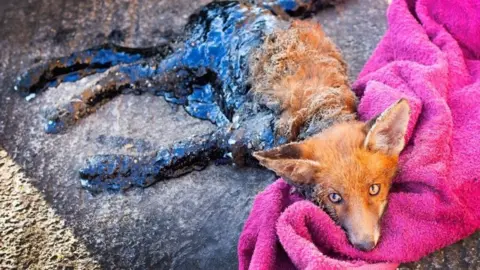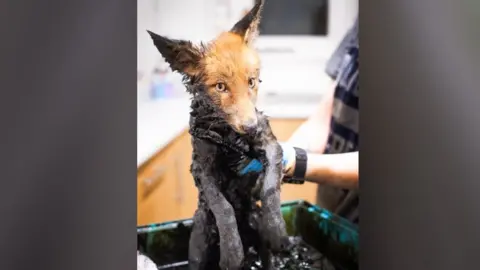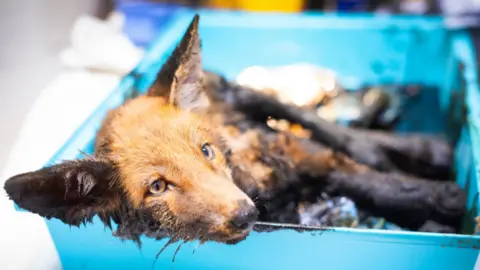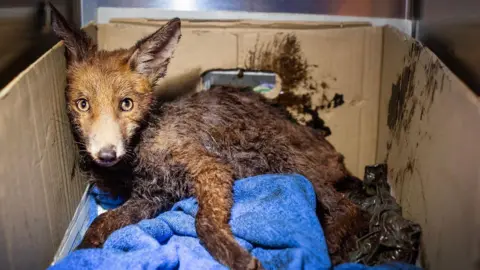Rescued fox 'coated in bitumen and stuck to road'
 South Essex Wildlife Hospital
South Essex Wildlife HospitalA wildlife hospital says treating a fox cub that got stuck in a container of bitumen and then to a road surface was one of its most horrific cases ever.
South Essex Wildlife Hospital was called out to find the fox covered in black gloop on an industrial estate in north-east London on Thursday.
It said that after hearing screeching, workers were able to locate the noise and free the three-month old cub from the container, but it then got stuck to the road.
The hospital hoped to be able to free the animal this week so that it would have a chance of reuniting with its mother, who was seen trying to rescue her cub.
Bitumen is made from crude oil and is mostly used as a binder in roads and the hospital called it "one of the most horrific cases we've seen in the 35+ years of wildlife rescue".
Lawrie Brailey, operations manager at the hospital, said the team arrived at the site near Lea Bridge and Hackney Marshes at about 19:00 BST.
Workers had looked up what to do online, and started using baby oil to try to free the fox while waiting for the professionals to arrive.
 South Essex Wildlife Hospital
South Essex Wildlife Hospital South Essex Wildlife Hospital
South Essex Wildlife HospitalIt then took a rescuer and vet more than 30 minutes to free each limb from the road before the fox could be taken away.
Baby oil and WD-40 was used to soften and dissolve the tar-like substance, however the hospital said its coat was so matted in some places that the fur had to be cut off.
Mr Brailey said: "There is minor staining to the fur... [but] now he looks like a fox, with a couple of patches missing."
However, the cub was being monitored for any toxicity effects.
"He seems to be fine and is now eating, urinating and defecating," said Mr Brailey.
The fox, while mobile, does have some damage to one of his legs and the team said it would work to start fixing it this week.
 South Essex Wildlife Hospital
South Essex Wildlife HospitalThe clean-up has taken more than 30 bottles of baby oil, and the hospital manager said he was just "glad" to free the stricken animal.
"We see a lot of injury, death… When you go to something like that and look at that animal.. you're then left wondering what you can do, and the problem is there's not much information on what we do; it's a lot of trial and error," he said.
At the incident, Mr Brailey said the cub's mother had tried to "scruff him" and "pick him up off the middle of the car park".
The hospital said it did not know if the cub could be reunited with its mother, which they believed would have to take place within a week or there was a chance of rejection.
If that was not possible, it would spend time with the other cubs they were treating in Essex and then be released when it was ready.
Follow Essex news on BBC Sounds, Facebook, Instagram and X.
